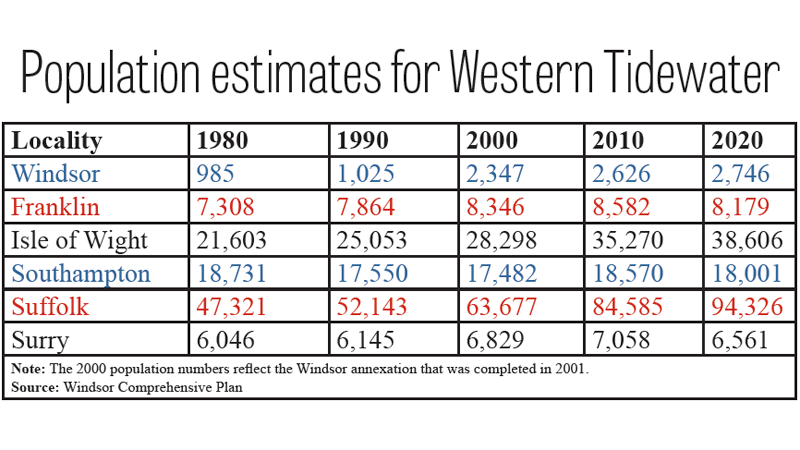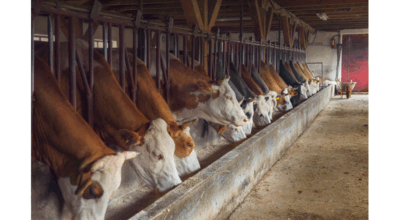Analyzing the character and dynamics of Windsor’s population
Published 9:04 pm Monday, October 16, 2023

- (Table designed by Jen Jaqua)
|
Getting your Trinity Audio player ready...
|
Windsor Planning and Zoning Administrator James “Jay” Randolph recently offered the town’s Planning Commission a look at the character and dynamics of Windsor’s population as town staff continues the early phases of updating Windsor’s Comprehensive Plan.
Randolph shared the draft of the plan’s updated second chapter, “Population,” during the commission’s Aug. 23 meeting.
“You may recall last summer when the 2020 Census numbers were released, we did review some of these numbers when that information first came out,” Randolph said to commissioners. “However, I’ve kind of condensed that information and put it into the population chapter.”
In the chapter, he noted that “the character and dynamics of a locality’s population are often good predictors of future development patterns and can act as valuable planning tools for a community making decisions related to growth. Future land use patterns are based in part on the trends seen in the existing community and involve an assessment of the need for housing, infrastructure, and other services.”
He wrote that the chapter examines the most recent population estimates, population growth trends and household information for the town using data from the U.S. Census Bureau, the Hampton Roads Planning District Commission and local records.
“(The chapter) does indicate that the 2020 population in the town of Windsor was 2,746,” Randolph said. “Isle of Wight County was at 38,606, and Virginia was a little over eight-and-a-half million persons.”
He and the chapter next addresses population growth trends in the Western Tidewater region, with the chapter including a table that shows population estimates in 1980, 1990, 2000, 2010 and 2020 for Windsor, Franklin, Isle of Wight County, Southampton County, Suffolk and Surry County.
“As you can see, most of the communities have experienced significant growth over the past 40 years, with the exception of Southampton and Surry — they’ve had some minor decreases in recent years,” Randolph said, “and a lot of that is due to how they count correctional facilities, whether (inmates are) from their home community or the community they’re actually housed in, there was some differences on that, which affected Southampton County in particular.”
However, he noted that the trend is for continued growth, adding that Windsor has grown at about a half percent per year.
“There are a lot of variables that go into the growth of a community,” he said. “For our town in particular, that’s going to be the availability of land, the zoning of that land and the development of those lands.
“As you’re aware, the Windsor Station subdivision was approved on Shiloh Drive last year, so as that project goes forward and is actually built and folks move into the subdivision, those numbers will be reflected in our future population projections,” he added.
In the Comprehensive Plan chapter, Randolph wrote that a population of 2,746 people in Windsor equates to a population density of 719 persons per square mile.
He stated that from 2020 to 2022, Isle of Wight County grew an additional 4%, bringing its estimated population total to 40,150.
The chapter then offers population projections for Windsor, with a total of 2,975 people projected by 2030, 3,350 projected by 2040 and 3,550 projected by 2045.
The final section of the chapter addresses population characteristics.
Randolph wrote that the 2020 Census showed that all the localities in the Western Tidewater region had a higher median age than either the state or the nation. In 2020, the median age of people in the U.S. was 38.8; in Virginia it was 38.4, with a plus/minus 0.1 margin of error; and in Windsor it was 47, with a plus/minus 8.2 margin of error.
Census data indicated that Windsor had a less racially diverse population than other Western Tidewater localities, Randolph stated, listing the following 2020 statistics: 69.5% of the town’s population was white alone; 21.3% was Black or African American alone; 1.2% was Asian; 0.05% was American Indian and Alaska native; and 2.4% were in the category of “other.”
The chapter notes that Windsor’s population is 52% female (1,428) and 48% male (1,318).
Randolph also highlighted in the chapter how Windsor has a higher percentage of minors and people older than 65 than the state or the nation. In the town, 23.2% of the population is younger than 18 compared to 22.1% for the country and 22% for Virginia. In the town, 20.9% of the population is older than 65 compared to 16.9% for Virginia and 16.8% for the country.
In the chapter’s conclusion, Randolph wrote, “The percentage of population growth for the town of Windsor has moderated over the past 10 years compared to the previous 30-year time period. A number of factors affect the growth and population patterns, including available housing opportunities, economic conditions at both the local and national level and other variables. The average household size continues to decrease, even though there are more multi-generational households.
“As we plan ahead to the year 2045, the town of Windsor can continue to expect to see an increase in the population consistent with the overall growth trends of the Western Tidewater region,” he wrote.





